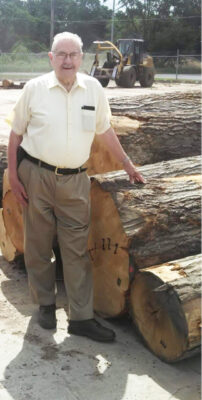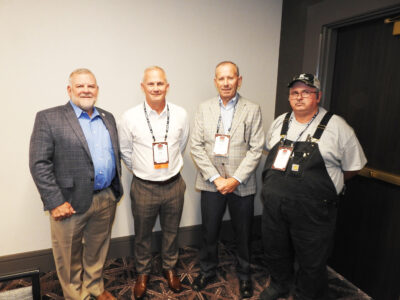Southeast Business Trends – April 2025
Market Improvements, Uncertainty And The Rise Of Red Oak And Poplar
Interest in Red Oak and Poplar have increased along with market demand and uncertainty about the tariffs, while White Oak inquiries have dropped, according to Southeastern lumber sources.
“Really good because I think people see what’s coming down the pike regarding availability or product,” is what a lumber representative in Alabama responded when asked about the market in his area, which is better than six months prior.
He explained they handle “all the grades coming out of the log” and predominately work with Ash, Poplar and Red and White Oak. They have seen a “lot of interest in Red Oak and Poplar.”
While they have a “whole realm of customers,” including doing some exporting, he listed distribution centers and millwork and manufacturing companies as examples.
He mentioned how the tariffs circling the trading markets have added a “lot of uncertainty,” while “trucking seems to be easing up a little bit compared to what it was eight or 10 months ago.”
According to a lumber source in Tennessee, the market is “pretty good” and has “gotten better the further we have gotten into the year.” It is “definitely better,” compared to six months ago. He believed this improvement is more “supply driven than demand driven. There’s not a ton of supply now mainly because of the weather and a lot of sawmills have gone out of business. There’s not as many places to supply lumber now as there once was.” He attributed the closure of these sawmills to the pandemic, which “seemed to be the start of all these places that went out of business. A lot of mills just didn’t come back from that and there’s just a lot of people getting out of the business.”
His company offers “all Appalachian species” such as Ash, Cherry, Hard and Soft Maple, Hickory, Poplar and Red and White Oak. In the “Oaks,” he said they work with “3A and Better,” while “everything else is 2A and Better.” Poplar and Red Oak are both “really good for us right now but the edge would go to the Poplar because we produce more Poplar than anything else.”
He said that his customers, which include distribution, moulding, trim and manufacturing companies, seem to have “gotten better because they must be taking on new orders.” They don’t export directly but “sell to other places that do,” as some of the companies they sell to send their lumber into Mexico, for which he expected there to be a “lag but so far, we haven’t seen anything yet.” His customers have all “kind of talked about” the tariffs but “don’t seem to be affected by anything yet.”
“Labor is a constant struggle in this industry no matter which direction people look,” he mentioned, continuing to state that he talks to “people all over the United States and everybody has the same issues.”
In Georgia, one lumber spokesperson is “more optimistic” than he has “been in a while” because “Red Oak is doing pretty well and so is Poplar.” Ash is “steady and the only thing getting hit hard is FAS White Oak. We’re not sure what is going to happen with it. It’s just the opposite of what we expected because six months ago, it was the easiest thing in the world to move and No.1 Common Red Oak was going to be the hardest thing to move. No. 2 Common Red Oak is not doing much. More often than not, when we sit there and think ‘that’s never going to move again,’ all of a sudden, it’ll take off and we’ll think it’ll be great forever but then it stops. Everything in the wood industry has been either feast or famine. No. 2 Common Ash is still slow. No. 2 Common Cypress is not doing well but Select Cypress seems to be doing pretty well; however, we haven’t cut any of that in so long. Ash and Southern yellow pine, specifically the higher grades like Merch and Prime, seem to be showing some activity and doing pretty well.”

He said that it is “much better than six months ago because it’s been gloom and doom for so long that being able to keep our head above water is nice. I’m optimistic right now.”
They primarily offer Red and White Oak, Poplar, Ash and Cypress in FAS No. 1 Common, No. 2 Common and “very little of 3A. We get some frame and it’s not doing very much but we don’t get very much anyways. I don’t lose sleep over it. Right now, FAS and No. 1 Common Red Oak are doing really well but No. 2 Common Red Oak is not doing well. If No. 2 Common is not doing well, 3A won’t do well and both are directly tied to the flooring industry such as residential flooring and truck or container flooring. If those are doing well and people are buying a bunch of lumber and taking them off the market, that helps us. Residential flooring seems like it’s showing some signs of life. We’re trying to move most of that green and not dry a lot of it.”
Far East Entrepreneurs
Their clientele is made up of truck and trailer customers and a “lot of export to Asian businesses in China and Vietnam. We’re starting to see a little bit more going to Mexico but that’s better for the people in the Midwest and areas like Mississippi. It’s easier for us to get to Savannah, GA, which caters to exporting to Asian countries in general. That’s most of our market and we have moulding and millwork customers for Poplar. It seems like the smaller custom moulding manufacturers want Poplar and Prime pine. If it’s custom-made, it seems to be doing better, according to our customers, which is understandable because I think people are starting to feel like they may not want to lose all the money they have for retirement and just decided to fix a few things up. The people who have a bit of money are starting to spend it toward the custom-made stuff but I think it’ll trickle down to housing and we’ll see it steadily get better across the board.”
Regarding the tariffs, he explained that it is a “wait and see” approach as to how everything will play out. He added that international businesses must have “prepared for it, which is why so much moved right before Chinese New Year because they wanted to replenish inventories. If there was a tariff, they would have lumber in inventory to last them two or three months to continue to move things into the market. I’ve had some inquiries from them recently so they’re still looking for some lumber to ship now. We weathered the tariffs then and we’ll weather them again. All they’re doing is giving themselves some negotiation points and they’ll settle on something. I think it won’t be as bad as everyone is expecting it to be.”








